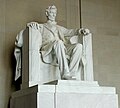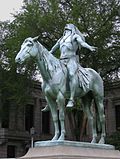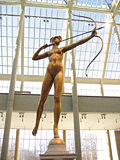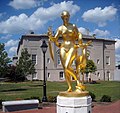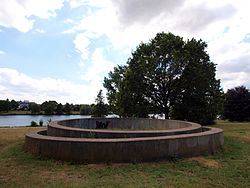Sculpture of the United States
 From Wikipedia - Reading time: 15 min
From Wikipedia - Reading time: 15 min

| This article is part of a series on the |
| Culture of the United States |
|---|
 |
| Society |
| Arts and literature |
| Other |
| Symbols |
| By Region |
|
United States portal |
The history of sculpture in the United States begins in the 1600s "with the modest efforts of craftsmen who adorned gravestones, Bible boxes, and various utilitarian objects with simple low-relief decorations."[1] American sculpture in its many forms, genres and guises has continuously contributed to the cultural landscape of world art into the 21st century.
Folk art
[edit]There is frequently art in well-made tombstones, iron products, furniture, toys, and tools—perhaps better reflecting the character of a people than sculptures made in classical styles for social elites. One of these specific applications, the carving of wooden figureheads for ships, started in the Americas as early as 1750[2] and a century later helped launch the careers of Samuel McIntyre and the country's first famous sculptor, William Rush (1756–1833) of Philadelphia.[3] The tradition begun then continues today in the folk sculpture style known as Chainsaw carving.
-
Gravestone from Boston, 1736 (?)
-
Ship's figurehead, artist unknown, c. 1830, Art Institute of Chicago
-
Preacher, c. 1830, Art Institute of Chicago
-
William Rush—portrait of General Andrew Jackson, 1815, Art Institute of Chicago
The Italian years
[edit]In the 1830s, the first generation of notable American sculptors studied and lived in Italy, particularly in Florence and Rome, creating the Neoclassic style. At that time, Italy "provided the proper atmosphere, brought the sculptor close to the great monuments of antiquity, and provided museum collections that were available to study."[4] They also gave the artists access to the carvers of Italy who translated their clay works into marble. During this period the themes from which the subjects of sculptural works were chosen tended to be drawn from antiquity, the exceptions being portraits (whose subjects were frequently shown wearing Roman or Greek garb) or works that included Native Americans. These artists included Horatio Greenough (1805–1852), Hiram Powers (1805–1873), Thomas Crawford (1814–1857), Thomas Ball (1819–1911) and his son-in-law William Couper (1853–1942), Harriet Hosmer (1830–1908), Chauncey Ives (1810–1894), Randolph Rogers (1825–1892) and (somewhat later) William Henry Rinehart (1825–1874).[5]
-
Horatio Greenough, Abdiel 1838–43
-
Thomas Crawford, David Triumphant, 1848
-
Hiram Powers — The Greek Slave, Raby Castle, 1844
-
Randolph Rogers, Nydia, the Blind Flower Girl of Pompeii, 1856
-
The Willing Captive by Chauncey Ives, 1871[6]
19th-century American women sculptors
[edit]American women also became active sculptors during the Italian Period despite the sexism of the age. Among the women who acquired both commissions and fame were Edmonia Lewis, Harriet Hosmer, Anne Whitney, Vinnie Ream and Emma Stebbins).[7]
-
Harriet Hosmer, Zenobia in chains, 1857, Saint Louis Art Museum
The Paris years
[edit]In the decades following the Civil War American sculptors began more and more to go to Paris to study — falling in with the more naturalistic and dramatic style exemplified by the works of Jean-Baptiste Carpeaux (1827–1875) and Antoine-Louis Barye (1796–1875) and other French sculptors. Among these Americans were Augustus Saint-Gaudens, Frederick MacMonnies, and Daniel Chester French.
-
Adams Memorial 1891, by Augustus Saint-Gaudens
-
Abraham Lincoln, 1920, the Daniel Chester French sculpture at the Lincoln Memorial, Washington, D.C.
-
Lincoln (detail), 1916, Daniel Chester French, Art Institute of Chicago
Home grown
[edit]American sculpture of the mid- to late 19th century was often classical and often romantic, but it showed a special bent for a dramatic, narrative, almost journalistic realism (especially appropriate for nationalistic themes) as witnessed by the frontier life depicted by Frederic Remington. This was the beginning of the style of "Western Art" that continued with Alexander Phimister Proctor and others through the 20th into the 21st century.
-
Cowboy at Rest by Solon Borglum, 1904
-
Cowboy by Frederic Remington, 1908
-
Appeal to the Great Spirit by Cyrus Dallin, 1909
-
Hudson McKnight Memorial, by Alexander Phimister Proctor, 1931
Animal sculptors (Animaliers)
[edit]The naturalism of the French school, exemplified by Antoine Barye, had a great impact on the first sculptors of American wildlife. The first generation of American animaliers included, Edward Kemeys, Edward Potter (who occasionally worked with Daniel Chester French, producing horses for his equestrian statues), Alexander Phimister Proctor (who executed mounts for Augustus Saint-Gaudens' riders), Charles Russell, Herbert Haseltine, Frederick Roth, Albert Laessle and Anna Hyatt Huntington.[8]
-
Edward Kemeys (1833–1907), Locked in Death, 1886
-
Albert Laessle (1877–1954), Billy, 1914
Public monuments
[edit]The years following the American Civil War saw a huge increase in the number of public monuments erected in the United States. "By far the most prevalent monument features a fully equipped Confederate soldier (the same prototype held true for Union monuments) in a realistic pose."[9] This style of monument was popularized by sculptor Martin Milmore who created one of the first ones in 1868. Milmore's own monument, authored by Daniel Chester French, Death and the Sculptor remains one of America's "noble tributes."[10]
As the century closed, the pace of monument-building quickened in the great cities of the East, especially those erected to memorialize the Civil War. Several outstanding sculptors emerged, most of them trained in the beaux-arts academies of Paris. Daniel Chester French stands out, as do Frederick William Macmonnies, Hans Schuler, and Lorado Taft. This tradition continued to the 1940s with Charles Keck, Alexander Stirling Calder and others and the use of figurative sculpture in monuments persists into the 21st Century. After the middle of the 20th Century sculpture used in public monuments was increasingly abstract.
The decades following the Second World War saw a large number of monuments and memorials dedicated to the victims of the Holocaust.
-
The Robert Gould Shaw Memorial, Boston Common, commemorates Shaw and the Afro-American 54th Massachusetts Volunteer Infantry, St. Gaudens
Carving mountains
[edit]There are at least three major mountain sculptures in the United States. These are Mount Rushmore, Stone Mountain, and Crazy Horse Memorial. Gutzon Borglum, an accomplished sculptor with such pieces as Seated Lincoln and a variety of other public monuments, oversaw the sculpture of Mount Rushmore in the Black Hills in South Dakota. The monument was finished after his death by his son Lincoln Borglum.
Gutzon Borglum also was responsible for starting the Stone Mountain project in Georgia but had a falling-out with its overseers. The monument was then taken up by Augustus Lukeman, who died during its carving in 1935. The memorial was finished by Walker Hancock and was considered complete in 1972.
The Crazy Horse Memorial in the Black Hills of South Dakota depicts the Oglala Lakota warrior Crazy Horse riding a horse and pointing into the distance. It was begun in 1948 by sculptor Korczak Ziolkowski and continued after his death by his wife, Ruth Ziolkowski, who took over the helm of the project, and several of their children.[11] The face was dedicated in 1998.
-
Mount Rushmore National Monument. Sculptures of George Washington, Thomas Jefferson, Theodore Roosevelt, and Abraham Lincoln represent the first 150 years of American history.
-
Stone Mountain in Georgia
Architectural sculpture
[edit]Public buildings of the last quarter of the 19th century and the first half of the 20th century provided an architectural setting for sculpture, especially in relief. Karl Bitter, Lee Lawrie, Adolph Alexander Weinman, C. Paul Jennewein, Rene Paul Chambellan, Corrado Parducci, and many others worked in the simple, sometimes narrative style that fit these spaces. Much of this work was created by anonymous sculptors and carvers.
-
North America, Philadelphia City Hall, Alexander Milne Calder, sculptor, 1870s
-
Lincoln issuing the Emancipation Proclamation, Nebraska State Capitol, Lee Lawrie, sculptor, c. 1925
-
Cane Cutter, Louisiana State Capitol, Lee Lawrie, sculptor, 1929
-
River Traffic, Kansas City City Hall, Walker Hancock, sculptor, 1937
Twentieth century
[edit]As the century began, many young European sculptors migrated to the free, booming economy across the Atlantic, and European trained sculptors account for much of the great work created before 1950. These include Elie Nadelman, Albin Polasek, Gaston Lachaise and Carl Milles.
-
Elie Nadelman sculpture in the New York State Theater
Modern Classicism
[edit]Several notable American sculptors joined in the revitalization of the classical tradition at this time, most notably Paul Manship, who "discovered" archaic Greek sculpture while studying on a scholarship in Rome. C. Paul Jennewein and Edward McCartan were also leaders in this direction who fit easily with the art-deco tastes of the 1920s. In the 1930s and 1940s, the ideologies that rent European politics were reflected in associations of American sculptors. On the right was the group, mostly native-born, mostly old-school classical, mostly modelers of clay, who founded the National Sculpture Society, led by the heiress and sculptor Anna Hyatt Huntington and preserved in the sculpture park that she endowed — Brookgreen Gardens in South Carolina.
-
Augustus Saint-Gaudens, Diana (1892–93)
-
Paul Manship, Duck Girl, 1916
-
Edward McCartan, Dionysus, 1923
American Expressionism
[edit]On the left, often immigrant, often expressionistic, was the New York-based Sculptors Guild, with an emphasis on more current themes and direct carving in wood or stone. One of its better known members was William Zorach.
-
Moses, William Zorach, 1952
African-American sculptors
[edit]With the Harlem Renaissance, an African-American sculpture genre emerged. Richmond Barthé was an outstanding example. Augusta Savage was a sculptor and teacher. Richard Hunt was the first to have a retrospective show at the Museum of Modern Art in 1971.[12] Other contemporary sculptors include Elizabeth Catlett, Martin Puryear, Jerry Harris, and Thaddeus Mosley.
Turn toward abstraction
[edit]Some Americans, such as Isamu Noguchi, had already moved from figurative to nonfigurative design, but after 1950, the entire American art world took a dramatic turn away from the former tradition, and America led the rest of the world into a more iconoclastic and theoretical approach to modernism.
Within the next ten years, traditional sculpture education would almost completely be replaced by a Bauhaus-influenced concern for abstract design. To accompany the triumph of abstract expressionist painting, heroes of abstract sculpture such as David Smith emerged, and many new materials were explored for sculptural expression. Louise Nevelson pioneered the emerging genre of environmental sculpture.
However, during this period a group of American sculptors persisted in creating works in their pre-war, modern/classical-style. These include Milton Horn, Donal Hord, Charles Umlauf, Joseph Erhardy, and John Henry Waddell.
Gallery of Modernist American sculpture
[edit]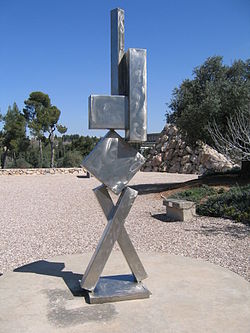
-
Gaston Lachaise (1882–1935), Floating Figure 1927, bronze, no. 5 from an edition of 7, National Gallery of Australia
-
Jacob Epstein (1880–1959), Day and Night, carved for the London Underground's headquarters, 1928.
-
Jacques Lipchitz (1891–1973), Birth of the Muses, (1944–1950).
-
Alexander Calder (1898–1976), L'empennage (1953)
-
Tony Smith (1912–1980), Free Ride, 1962, 6'8 x 6'8 x 6'8 (the height of a standard US door opening), Museum of Modern Art, New York
-
Larry Bell (born 1939), Untitled 1964, bismuth, chromium, gold, and rhodium on gold-plated brass; Hirshhorn Museum and Sculpture Garden
-
Isamu Noguchi (1904–1988), Heimar, 1968, at the Billy Rose Sculpture Garden, Israel Museum, Jerusalem, Israel
-
George Rickey (1904–2002), Four Squares in Geviert, 1969, terrace of the New National Gallery, Berlin, Germany
-
Richard Serra (born 1939), Fulcrum 1987, 55 ft high free standing sculpture of Cor-ten steel near Liverpool Street station, London
Pushing the boundaries of art
[edit]The figure returned in the 1960s, but without the beaux-arts figurative tradition, sometimes even as life-casts like those George Segal made with plaster. Jim Gary created life-sized figures composed of metal washers and hardware almost invisibly welded together, as well as those of stained glass and even used automobile parts and tools in his sculptures.
Concerns for the qualities of forms and design continued — but usually without representing a human figure. Minimalist sculpture by artists such as Richard Serra and Norman Carlberg often replaced the figure in public settings. Sculpture of the late 20th century was mostly a playful exploration of the boundaries of what could be called art.
Minimalism
[edit]The Minimalist style reduces sculpture to its most essential and fundamental features. Minimalists include Tony Smith, Donald Judd, Robert Morris, Larry Bell, Anne Truitt, and Dan Flavin;
Site-specific movement
[edit]
Site specific and environmental art works are represented by artists: Donald Judd, Dennis Oppenheim, Richard Serra, Robert Irwin, George Rickey, and Christo and Jeanne-Claude led contemporary abstract sculpture in new directions. Artists created environmental sculpture on expansive sites in the 'land art in the American West' group of projects. These land art or 'earth art' environmental scale sculpture works exemplified by artists such as Robert Smithson, Michael Heizer, James Turrell (Roden Crater) and others The land art (earth art) environmental scale sculpture works by Robert Smithson, Michael Heizer, James Turrell and others.
Postminimalism
[edit]Artists Bill Bollinger, Eva Hesse, Sol LeWitt, Jackie Winsor, Keith Sonnier, Bruce Nauman, and Lucas Samaras, among others were pioneers of Postminimalist sculpture. The later works of Robert Graham continued evolving, often in public art settings, into the 21st century.
Also during the 1960s and 1970s artists as diverse as Stephen Antonakis, Chryssa, Walter De Maria, Dan Flavin, Robert Smithson, Dennis Oppenheim, Robert Irwin, Claes Oldenburg, George Segal, Edward Kienholz, Duane Hanson, and John DeAndrea explored abstraction, imagery and figuration through Light sculpture, Land art, and installation art in new ways.
Late 20th-century revival of figurative sculpture
[edit]
Other kinds of sculpture grew in importance, some evolving from the work of leaders in ironwork during the early 1900s who included Samuel Yellin. A center for the western style of American sculpture developed at Loveland, Colorado, and many studios, magazines, and even a museum (the National Cowboy & Western Heritage Museum in Oklahoma City) pursued this interest. A neo-Victorian style emerged, pioneered by the sculptor Frederick Hart.
Other genres of sculpture
[edit]The art-doll and ceramic sculpture communities also grew in numbers and importance in the late 20th century, while the entertainment industry required large-scale, spectacular (sometimes monstrous or cartoon-like) sculpture for movie sets, theme parks, casinos, and athletic stadiums. Industrial product design, especially automobiles, should not be ignored. An example is Randolph Parducci's (brother of Corrado Parducci) sculptures created for the famous chariot race scene in the film Ben Hur.
Legal issues regarding photographs
[edit]United States courts have consistently held that sculptors maintain an intellectual property right to sculptures and are entitled to compensation if photographs are used for commercial purposes. The rights apply even if the sculptor no longer owns the sculpture or the sculpture is not even in a public space. The sculptor, however, could sign away those rights. Some other countries, such as Germany, give permission to take the photographs via the concept of Panoramafreiheit, or Freedom of Panorama.

On February 25, 2010, the United States Court of Appeals for the Federal Circuit ruled 2-1 that the Frank Gaylord, sculptor of the Korean War Veterans Memorial, was entitled to compensation because an image of it was used on a 37 cent U. S. postage stamp and he had not signed away his intellectual property rights. The appeals court rejected arguments that the photo was transformative.[13]
In 2002, amateur photographer and retired Marine John All was paid $1,500 to use one of his photographs of the memorial on a snowy day for the stamp[14] which sold more than $17 million worth of stamps. In 2006, sculptor Frank Gaylord enlisted Fish & Richardson to make a pro bono claim that the U. S. Postal Service had violated his intellectual property rights to the sculpture and thus he should have been compensated. The Postal Service argued that Gaylord was not the sole sculptor (saying he had received advice from federal sources – who recommended that the uniforms appear more in the wind) and also that the sculpture was actually architecture. Gaylord won all of his arguments in the lower court except for one...the court ruled the photo was fair use and thus he was not entitled to compensation. Gaylord appealed the fair use ruling and won the case on appeal.[13] On April 22, 2011, The US Court of Claims awarded Gaylord $5,000.[15]
See also
[edit]- Statues of the National Statuary Hall Collection
- Pedimental sculptures in the United States
- History of sculpture
Notes
[edit]- ^ Craven, Wayne, ‘’Sculpture in America’’, Thomas Y. Crowell Company, New York, 1968, p. 1
- ^ Pinckney, Pauline A. ‘’American Figureheads: And Their Carvers’’, W.W. Norton & Company, Inc. NY 1940 p.29
- ^ Brewington, M.V., ‘’Shipcarvers of North America’’, Dover Publications, New York, 1972 c.1962 p. 26-40
- ^ Rogers, Millard F., ‘’Randolph Rogers: American Sculptor in Rome’’, University of Massachusetts Press, 1971 p. 13
- ^ Crane, Sylvia E., ‘’White Silence: Greenough, Powers and Crawford, American Sculptors in Nineteenth-Century Italy’’, University of Miami Press, Coral Gables, 1972 p. xiii
- ^ "The Willing Captive, (sculpture)". Inventories of American Painting and Sculpture, Smithsonian American Art Museum. Retrieved February 16, 2012.
- ^ Rubenstein, Charlotte Streifer, ‘’American Women Sculptors: A History of Women Working in Three Dimensions’’, G. K. Hall and Co. Boston, 1990
- ^ McKay, James, The Animaliers: A Collectors Guide to the Animal Sculptors of the 19th and 20th centuries, E.P. Dutton, New York, 1973
- ^ Widener, Ralph W., ‘’Confederate Monuments: Enduring symbols of the South and the War Between the States’’, Andromeda Press, Washington D.C. 1982, introduction
- ^ Taft, Lorado, ‘’The History of American Sculpture’’, The Macmillan Company, New York, 1925 p. 255
- ^ "Ruth Ziolkowski obituary: Driving force behind a decades-long project to sculpt a vast memorial to Crazy Horse out of the Black Hills of Dakota". The Guardian. 2014-05-27. Retrieved 2014-06-21.
- ^ Introduction by Courtney J. Martin. Text by John Yau, Jordan Carter, LeRonn Brooks. Interview by Adrienne Childs. (2022). Richard Hunt. GREGORY R. MILLER & CO. ISBN 9781941366448.
{{cite book}}: CS1 maint: multiple names: authors list (link) - ^ a b "An 85-Year-Old Sculptor vs. The Government". AmLawDaily. February 25, 2010.
- ^ Friedman, Peter (2009-07-23). "Easy Case: Postage Stamp is Fair Use of Korean War Veterans Memorial". Ruling Imagination: Law and Creativity. Archived from the original on 2012-07-09. Retrieved 2017-04-19.
- ^ Mike Doyle (April 25, 2011). "Korean War memorial sculptor wins and loses at the same time". McClatchy.
References
[edit]- Armstrong, Craven, et al., 200 Years of American Sculpture, Whitney Museum of Art, NYC, 1976
- Caffin, Charles H., American Masters of Sculpture, Doubleday, Page & Company, New York 1913
- Conner, Janis and Joel Rosenkranz, Rediscoveries in American Sculpture, Studio Works 1893–1939, University of Texas, Austin, Texas 1989
- Contemporary American Sculpture, The California Palace of the Legion of Honor, Lincoln Park, San Francisco, The National Sculpture Society 1929
- Craven, Wayne, Sculpture in America, Thomas Y. Crowell Co, NY, NY 1968
- DeWall, Robb, Crazy Horse and Korczak: The Story of an Epic Mountain Carving, Illustrations by Marinka Ziolkowski, Korczak's Heritage, Inc. Crazy Horse, SD, 1982
- Falk, Peter Hastings, Editor, Who Was Who in American Art, Sound View Press, Madison Connecticut, 1985
- Fort, Ilene Susan, The Figure in American Sculpture: A Question of Modernity, Los Angeles County Museum of Art & University of Washington Press, Los Angeles, CA 1995
- Gadzinski, Susan James and Mary Mullen Cunningham, American Sculpture in the Museum of American Art of the Pennsylvania Academy of Fine Arts, Museum of American Art of the Pennsylvania Academy of Fine Arts Philadelphia 1997
- Greenthal, Kozol, Rameirez & Fairbanks, American Figurative Sculpture in the Museum of Fine Arts, Boston, Museum of Fine Arts, Boston 1986
- Gridley, Marion E., America’s Indian Statues, Marion E. Gridley, Chicago, Illinois 1966
- Kvaran, Einar Einarsson, Architectural Sculpture in America, unpublished manuscript
- McSpadden, J. Walker, Famous Sculptors of America, Dodd, Mead and Company, Inc. New York 1924
- Navarra, Tova, Jim Gary: His Life and Art, HFN, New York 1987
- Opitz, Glenn B, Editor, Mantle Fielding’s Dictionary of American Painters, Sculptors & Engravers, Apollo Book, Poughkeepsie NY, 1986
- Proske, Beatrice Gilman, Brookgreen Gardens Sculpture, Brookgreen Gardens, South Carolina, 1968
- Reynalds, Donald Martin, Masters of American Sculpture: The Figurative Tradition From the American Renaissance to the Millennium, Abbeville Press, NY 1993
- Rubenstein, Charlotte Streifer, American Women Sculptors, G.K. Hall & Co., Boston 1990
- Smith, Rex Allen, The Carving of Mount Rushmore, Abbeville Press, New York 1985
- Taft, Lorado, The History of American Sculpture, MacMillan Co., New York, NY 1925
 KSF
KSF






![The Willing Captive by Chauncey Ives, 1871[6]](https://upload.wikimedia.org/wikipedia/commons/thumb/2/2d/The_Willing_Captive.jpg/120px-The_Willing_Captive.jpg)





